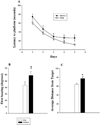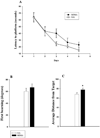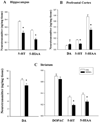3,4-Methylenedioxymethamphetamine in adult rats produces deficits in path integration and spatial reference memory
- PMID: 16324685
- PMCID: PMC2888296
- DOI: 10.1016/j.biopsych.2005.09.006
3,4-Methylenedioxymethamphetamine in adult rats produces deficits in path integration and spatial reference memory
Abstract
Background: +/-3,4-Methylenedioxymethamphetamine (MDMA) is a recreational drug that causes cognitive deficits in humans. A rat model for learning and memory deficits has not been established, although some cognitive deficits have been reported.
Methods: Male Sprague-Dawley rats were treated with MDMA (15 mg/kg x 4 doses) or saline (SAL) (n = 20/treatment group) and tested in different learning paradigms: 1) path integration in the Cincinnati water maze (CWM), 2) spatial learning in the Morris water maze (MWM), and 3) novel object recognition (NOR). One week after drug administration, testing began in the CWM, then four phases of MWM, and finally NOR. Following behavioral testing, monoamine levels were assessed.
Results: +/-3,4-Methylenedioxymethamphetamine-treated rats committed more CWM errors than did SAL-treated rats. +/-3,4-Methylenedioxymethamphetamine-treated animals were further from the former platform position during each 30-second MWM probe trial but showed no differences during learning trials with the platform present. There were no group differences in NOR. +/-3,4-Methylenedioxymethamphetamine depleted serotonin in all brain regions and dopamine in the striatum.
Conclusions: +/-3,4-Methylenedioxymethamphetamine produced MWM reference memory deficits even after complex learning in the CWM, where deficits in path integration learning occurred. Assessment of path integration may provide a sensitive index of MDMA-induced learning deficits.
Figures






References
-
- Alyan S, McNaughton BL. Hippocampectomized rats are capable of homing by path integration. Behav Neurosci. 1999;113:19–31. - PubMed
-
- Balcombe JP, Barnard ND, Sandusky C. Laboratory routines cause animal stress. Comtemp Top Lab Anim Sci. 2004;43:42–51. - PubMed
-
- Bhattachary S, Powell JH. Recreational use of 3,4-methylenedioxymethamphetamine (MDMA) or “ecstasy“: Evidence for cognitive impairment. Psychol Med. 2001;31:647–658. - PubMed
-
- Cho AK, Melega WP, Kuczenski R, Segal DS. Relevance of pharmacokinetic parameters in animal models of methamphetamine abuse. Synapse. 2001;39:161–166. - PubMed
Publication types
MeSH terms
Substances
Grants and funding
LinkOut - more resources
Full Text Sources
Medical

